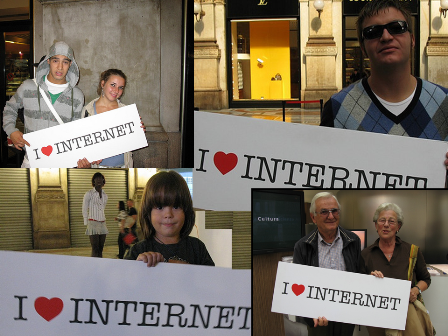Teach Digital Inclusion
[draft updated 27 Nov 2010]
Introduction
This page provides presentation materials and supporting resources to encourage instructors to teach digital inclusion. It is a work-in-progress. Please send any comments and suggestions to shawn@uiaccess.com and include in the subject "Teach Digital Inclusion" or call +1-617-395-7664.
- A draft multimedia presentation with visuals and audio
- A PowerPoint presentation that you can customize for your own presentations, with appropriate attribution
- A transcript of the audio ("narrative") along with the visuals in the table below; as well as speaker notes
- Resources for teaching digital inclusion
- References for the presentation and additional study
Presentation Version 0.1, 27 November 2010
The information below is in support of the multimedia and PowerPoint presentations listed above.
| Visual "slide" | Narrative | Notes | |
|---|---|---|---|
| 1 | What if there was one thing you could do as an instructor
|
||
| 2 | There is: Teach Digital Inclusion. Digital inclusion is about ensuring equal access to information and communications technologies (ICT)... |
||
| 3 | ...specifically, digital inclusion addresses:
|
Image 1 (mouthstick): Copyright © 2001 Shawn Lawton Henry. (see image permissions) Image 2: Stephen Hawking Image 3 (older user): Copyright © 2008 Shawn Lawton Henry. (see image permissions) Image 4: Generator Powering Mobile ICT Center by By Wayan Vota Image 5: girl in classroom |
|
| 4 | A briefly note about terminology: digital inclusion is related to design for all, inclusive design, universal design, e-inclusion, and similar terms. |
||
| 5.1 | While Internet access is a primary focus of digital inclusion, it also covers telephony, TV, kiosks, and other ICT. The Internet is increasingly becoming the only means of accessing some types of information and services, -- totally replacing traditional resources and service delivery. |
||
| 5.2 | In more and more cases, people must use the Internet and other technology... whether they want to or not. Thus it is essential that it is inclusive. |
Image from codiceinternet | |
| 6 |  |
When technology is inclusive, it can be amazingly empowering. For example, the Web is providing unprecedented access to information and interaction for people with disabilities. That is, the accessibility barriers to print, audio, and visual media can be much more easily overcome through web technologies. (Henry and Arch 2010) The Web provides opportunities to participate in society in ways otherwise not available. With accessible websites, people with disabilities can do ordinary things: children can learn, teenagers can flirt, adults can make a living, seniors can check on their investments. With the Web, people with disabilities can do more things themselves, without having to rely on others. People who are blind can read the newspaper (through screen readers that read aloud text from the computer), and so can people with cognitive disabilities who have trouble processing written information. People who are deaf can get up-to-the-minute news that was previously available only to those who could hear radio or TV, and so can people who are blind and deaf (through dynamic Braille displays). People with quadriplegia who cannot move their arms or legs can shop online to get groceries, gadgets, and gifts delivered. People who cannot speak can participate in online discussions, through blogs, twitter, facebook, etc. (Henry 2006) People with disabilities can have more effective and efficient access to information through accessible websites — in some cases, where there was essentially no access to it before. (Henry and Arch 2010) Thus the impact of disability is radically changed on the Web because the Web removes barriers to communication and interaction that many people face in the physical world... |
Henry, S.L. (2006) Chapter 1: "Understanding Web Accessibility". In Web Accessibility: Web Standards and Regulatory Compliance, friends of ED/Apress, Berkeley, CA, USA. Henry, S.L. and Arch, A. (2010) Social Factors in Developing a Web Accessibility Business Case for Your Organization Images 1, 2, 3, 4 from codiceinternet
|
| 7 |  |
... However, when websites, web technologies, or web tools are badly designed, they can create barriers that exclude people from using the Web. (Henry and McGee 2009) So many people are currently excluded from ICT. Sadly, one reason is simply that instructors are not teaching their students about digital inclusion. |
Henry, S.L. and McGee, L. (2009) Accessibility - W3C |
| 8 | Here is one story of digital inclusion - and exclusion. Dr. John Slatin was an English professor at University of Texas. He embraced the Internet as a way for individual's voices to be heard and allow people to collaborate, without having to go through formal publication channels. John developed retinitis pigmentosa and his sight gradually deteriorated until he was blind. He used technology to continue in his work and became an international expert. He was adept at using screen readers to interact with computers. However, some applications were not accessible to John because they were poorly designed. In 2005, John was diagnosed with leukemia. He needed to research life-and-death decisions on treatment options. But John found that many of the websites that provide such information on treatments were not accessible. He was locked out of getting access to vital life-saving information. John kept family and friends up-to-date on his daily struggles through a blog called Leukemia Letters. It was an outlet for a talented writer in difficult times and an important way to keep connected with his family, friends, and colleagues around the world. But then the vendor updated the blogging software - and in the process made it inaccessible to John. He was again locked out of communicating with those who cared deeply for him. Technology can be incredibly enabling, or disabling. John is just one of billions of people impacted by how we design, develop, and deploy technology. There are similar stories all around you. It is essential that we teach digital inclusion. |
John's story is from the personal knowledge of Shawn Lawton Henry and Sharron Rush. Information supporting some of the points is available in:
Image: fundamentos web |
|
| 9 | Digital inclusion is a human right. This human right is recognized in policies in many parts of the world. For example the United Nations Convention on the Rights of Persons with Disabilities states that people should be enabled to live independently and participate fully in all aspects of life equally through access to information and communications technologies, both in urban and in rural areas. (United Nations 2006) Teach your students to support people's human rights. |
United Nations (2006) Convention on the Rights of Persons with Disabilities
|
|
| 10 | Digital inclusion is increasingly a legal requirement. Equal rights are often addressed anti-discrimination regulations, which are now explicitly including ICT. Teach your students to meet legal requirements for technology.
|
Note to speakers: Customize this and the previous slide information with regulations that impact your audience, covering people with disabilities, people who are older, people in rural areas, and other people listed in narrative for Slide 3. |
|
| 12 | Digital inclusion economically benefits government. For example, it saves government money to provide communications, interactions, and services electronically instead of by paper, mail, in-person, phone, etc. (HM 2009) When citizens have better access to education, employment opportunities, and health care, the costs of social services can be reduced. (EU 2010) Digital inclusion can increase citizen productivity, financial situation, and consumption of goods, resulting in a stronger position in the global economy. (EC 2007, Wright and Wadhwa 2010, EU 2008)] |
HM Government (2009) Delivering Digital Inclusion An Action Plan for Consultation. European Commission (2010), Digital Agenda for Europe: what would it do for me? Wright, D. and Wadhwa, K. (2010). Mainstreaming the e-excluded in Europe: strategies, good practices and some ethical issues. European Commission (2008) Commission Communication “Towards an accessible information society” Background note, December 2008 |
|
| 11 | Better education, higher employment rates, better health care, better participation in community and government, more independent living — are all aspects of digital inclusion that also economically benefit society. Your students can positively impact society through digital inclusion. |
||
| 13 | Digital inclusion economically benefits businesses and other organizations. When the broad range of people and situations are considered early in design, it opens designers to different perspectives that can lead to exciting innovations and result in better products for everybody. Creating inclusive products increases potential customers, improves employee recruiting and retention, can decrease costs, reduces legal risk, and demonstrates corporate social responsibility. (Law 2006, Henry and Arch 2010) |
Law, C.M. (2006) The technology in your cell phone wasn't invented for you. Henry, S.L. and Arch, A. (2010) Developing a Web Accessibility Business Case for Your Organization |
|
| 14 | Students who can bring these benefits to their potential employers can themselves reap economic benefits of digital inclusion. Instructors who understand digital inclusion are also more valuable. As individuals we benefit from digital inclusion through:
|
||
| 15 | Digital inclusion benefits us all. In a report on Why ICT research is even more important in the aftermath of the financial crisis, European Commissioner Viviane Reding said: “ICT is the principal motor of growth and competitiveness of industries, the driver of efficiency and effectiveness of our public sector and the means of raising the quality of life of our citizens.” (Reding, 2008) Digital inclusion is essential for society, for government, for businesses, for individuals. Digital inclusion is essential for people with disabilities; people who are older; people in rural and remote areas; people with low literacy; people with low income; and billions of people around the world who are socially, economically, and geographically disadvantaged. |
Reding, V. (2008). Why ICT research is even more important in the aftermath of the financial crisis. |
|
| 16 | There is one thing you can do as an instructor to vastly improve people’s lives around the world, increase your worth as an instructor, and better prepare your students for their next steps in life:... |
||
| 17 | teach digital inclusion. |
||
| 18 | For resources the help you teach digital inclusion and references for this presentation, see www.uiAccess.com/teachDI.html |
||
| 19 |  |
I'm Shawn Henry, and I'm one of those stories. Thank you for your efforts to make the world more inclusive. |
Resources
There are many resources to help you teach digital inclusion. For example:
- Developing Web Accessibility Presentations and Training
- Masters and bachelor level curriculum guidelines
More will be listed here...
References
Several references are in the Notes column of the presentation table. More will be listed here...
Permission to Use
 Teach Digital Inclusion by Shawn Lawton Henry is licensed under a Creative Commons Attribution-NonCommercial 3.0 Unported License. You have permission to use it provided you include attribution and tell me how you use it (e-mail and phone below). Feedback and suggestions for the next revision are welcome.
Teach Digital Inclusion by Shawn Lawton Henry is licensed under a Creative Commons Attribution-NonCommercial 3.0 Unported License. You have permission to use it provided you include attribution and tell me how you use it (e-mail and phone below). Feedback and suggestions for the next revision are welcome.
Images
Most images are creative commons licensed by their copyright holders; information is linked in the Notes column.
For images that are Copyright Shawn Lawton Henry, you are granted permission to use for presentations that promote digital inclusion, provided you include the copyright notice. Contact Shawn about use in other situations.
Contact
Please send any comments and suggestions to:
shawn@uiaccess.com and include in the subject "Teach Digital Inclusion"
or call +1-617-395-7664.
